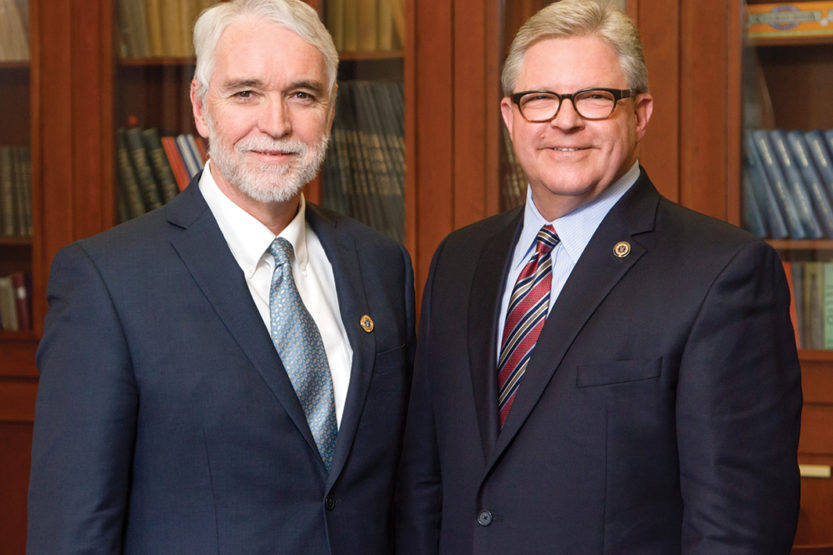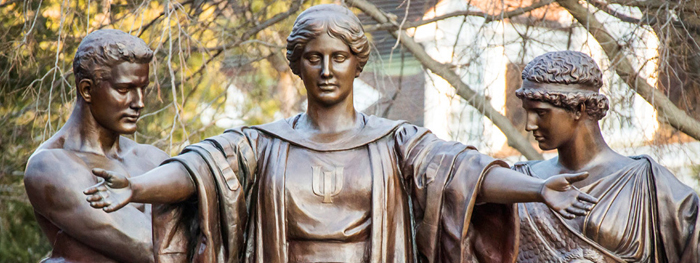21st Century Leader
 Timothy Killeen - 20th president of the University of Illinois and Loren Taylor, UI Alumni Association CEO
Timothy Killeen - 20th president of the University of Illinois and Loren Taylor, UI Alumni Association CEO When Timothy “Tim” Killeen was 23 and looking for his first professional position, he had an important credential—a doctorate from University College London, where he had studied positrons. The positron, a particle that inhabits the subatomic realm, today is used in 3-D medical imaging technology to diagnose conditions ranging from cancer metastasis to neurological disorders to bacterial infection.
But in 1975, most of the world, even the scientific one, didn’t know much about positrons. Fortunately for Killeen, David Rees did. A professor whose office was down the hall from Killeen’s lab at UCL, Rees hired the young Welsh postdoc. The next thing Killeen knew, he was on a beach off the coast of Norway firing rockets at the Northern Lights. Turned out his experience with experimental positronics gave him a useful set of tools for analyzing that incomparable phenomenon—aka the Aurora Borealis, which spires and flames in the night skies around the Arctic Circle.
“That was my introduction to geosciences,” Killeen recalls. “I got the bug.”
This early career shift would take Killeen’s research higher and higher—literally. Over the course of four decades, he has intensively studied the vast system that comprises Earth’s upper atmosphere. A telescope array he developed now rides onboard a NASA satellite. Killeen has taught and mentored students, and promoted geoscience research worldwide. His progress through administrative posts also has been in ascent mode—all the way to the presidency of the University of Illinois, which he officially assumes on May 18.
“With each step, it’s felt to me that the interests have broadened and the responsibilities have broadened,” Killeen, 62, said in a recent phone interview from his home in Albany, N.Y. “I see the University of Illinois as the culmination of all of my previous experiences. I’m very excited about the opportunities and the possibilities. And I’m deeply honored that I was selected for this job.”
New research and new skill sets
The search for the 20th president of the University of Illinois three-campus system took a 19-member search committee eight months. The committee reviewed the credentials of hundreds of highly qualified prospects. When University trustees made their final selection from the recommended candidates last November, their support for Killeen was unanimous. Citing Killeen’s accomplishments, UI physics professor Douglas Beck, who co-chaired the search committee, observed, “Tim is an award-winning teacher and researcher with a broad range of administrative experience. He is articulate and quick-witted. What’s not to like?”
That unanimous vote did not mean Killeen was a conventional choice. He has never been a college dean or a campus chancellor—time-honored precursors to the role of university president. His administrative experience has revolved, somewhat as his telescopes do, around science and technology.
Presently, Killeen serves as vice chancellor of research for the 64-campus State University of New York system. He also served as president of the SUNY Research Foundation—a post he resigned from in January in anticipation of the move to Illinois—where he oversaw a $900 million portfolio of government and private grants and contracts across a universe of disciplines, from computer science and nanotechnology to the arts and social sciences.
In a 21st century where technology burgeons and government funding shrinks, Killeen brings to the University of Illinois a profound understanding of research as the lifeblood of higher education and of society itself.
“The challenges we face into the foreseeable future are going to require skill sets and a knowledge base forged in the academy,” he says. “We will have to come forward with equitable solutions for tough societal challenges. And those solutions are going to come through new knowledge from research universities—in health care, in technology, in natural and social sciences, in engineering, and in understanding and celebrating the human experience through the arts and humanities.”
“We need brilliant people who have skill sets that are appropriate for our time,” Killeen says, meaning students and alumni of the University of Illinois.
A ‘great geoscientist’
Education is embedded in Killeen’s very bones. He grew up in Cardiff, the capital of Wales, among a clan of Irish Catholics so extended that, he says, “I had 34 first cousins.” His mother was a physician—just the second woman to earn her M.D. from Cardiff University. His father was a mining engineer who worked in the private sector and taught university courses. Of Killeen’s four siblings, two are doctors, one is a teacher, and one is a nuclear physicist. When he headed to University College London, Killeen majored in physics because, he recalls, “I felt that if I mastered something really hard, I would be able to do things that might be easier later.”
That reversal of direction toward “easier” never took place. By age 23, Killeen was firing rockets in arctic Norway. Three years later, he headed for the University of Michigan Space Physics Research Laboratory, which designs and fabricates instruments for NASA and other organizations, including the U.S. Dept. of Defense and the European Space Agency. Among the highlights of his two-plus decades in Ann Arbor was the launch of NASA’s Dynamics Explorer, a polar-orbiting satellite equipped with an optical remote sensing interferometer that Killeen helped create under the guidance of his mentor, Paul Hays, now professor emeritus at Michigan.
“I was driven to work as part of a team on the whole thing: design, build, deploy, measure, understand, model and write it up,” Killeen recalls. “People didn’t know whether I was a theorist or an experimentalist, which I kind of liked.”
Killeen spent 23 years at Michigan and was involved in SPRL-designed spacecraft that journeyed to Venus, Jupiter and Saturn. Eventually, he became director of SPRL. He led the team in 2003 that developed an instrument that still is aloft aboard the NASA satellite TIMED. Known as TIDI (an acronym that happens to sound like the Welsh word for “grandpa”), Killeen’s instrument provides a stream of optical atmospheric data from the satellite’s pole-to-pole orbit, which twice daily covers the entire surface of Earth.
“Some of the results have been very interesting,” he observes. “For example, the planet turns with respect to the sun and so do upper atmospheric tidal structures, like the jet stream. But we have seen, with TIDI, systems that are going in the opposite direction, completely anti-intuitive, which are related to the coupling between the lower atmosphere and the upper atmosphere.”
In 2000, Killeen moved to Boulder, Colo., to direct the world-renowned National Center for Atmospheric Research. Eight years later, he took a leadership position in geosciences with the National Science Foundation in Arlington, Va. He crossed career paths in both places with friend and colleague Margaret Leinen ’69 LAS. Leinen now leads the Scripps Institution of Oceanography at the University of California, San Diego, and is president of the American Geophysical Union, a prestigious scholarly society that Killeen headed from 2006-08.
“Some of the highlights of Tim’s time at NCAR included its development of a new high-altitude research aircraft and a key role in climate modeling,” Leinen writes in an email. “He is a creative administrator and led the effort to expand the interdisciplinary climate-related research at NSF that has contributed so much to our knowledge of climate impacts. As an alum, I was delighted to hear that this great geoscientist is coming to the University. It’s about time!”
Mastering complex systems
Killeen is married to geophysicist Roberta Johnson, and the couple have three children of whom they are “desperately proud.” He and his wife will relocate to Illinois (maintaining residences in both Urbana and Chicago) this spring from SUNY, where they have been based since 2012.
Killeen’s career has been marked by numerous accolades, ranging from excellence in teaching and research awards at Michigan to election to the National Academy of Engineering to an honorary doctorate from his alma mater in London.
The complex geophysical system of planet Earth has been Killeen’s life’s work. Now he’s faced with mastering a very different complex system: the University of Illinois. To that end, he notes, “I’ve been doing my homework”—spending a great deal of time on all three campuses and meeting a great many people.
“My impression is that the University of Illinois is venerated externally at levels that probably are beyond its internal self-image,” he says. “And part of my job is to raise that level of aspiration and confidence in the excellence we have. I have the advantage of having looked at it from the outside for many years. Roberta and I are both in awe of this University. ”
The greater challenge is in leading this major research institution through a future of limitless and rapidly changing possibilities. While research funding to the U of I topped $914 million in FY14, the potential for that figure to go much higher is enormous.
Tim Killeen knows his new job is not going to be rocket science. It will be so much more than that.

